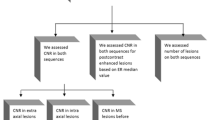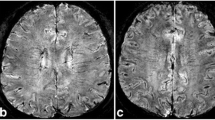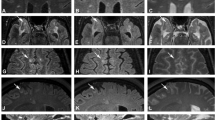Abstract
Discrepancies exist in the literature regarding contrast between gray and white matter on spin-echo (SE) T1-weighted MR imaging at 3 T. The present study quantitatively assessed differences in gray matter-white matter contrast on both single- and multi-slice SE T1-weighted imaging between 3 and 1.5 T. SE T1-weighted sequences with the same parameters at both 3 and 1.5 T were used. Contrast-to-noise ratio (CNR) between gray and white matter (CNRGM-WM) was evaluated for both frontal lobes. To assess the effects of interslice gap, multi-slice images were obtained with both 0 and 25% interslice gap. Single-slice CNRGM-WM was higher at 3 T (17.66 ± 2.68) than at 1.5 T (13.09 ± 2.35; P < 0.001). No significant difference in CNRGM-WM of multi-slice images with 0% gap was noted between 3 and 1.5 T (3T, 8.61 ± 2.55; 1.5T, 7.43 ± 1.20; P > 0.05). Multi-slice CNRGM-WM with 25% gap was higher at 3T (12.47 ± 3.31) than at 1.5 T (9.73 ± 1.37; P < 0.001). CNRGM-WM reduction rate of multi-slice images with 0% gap compared with single-slice images was higher at 3T (0.47 ± 0.13) than at 1.5 T (0.38 ± 0.09; P = 0.02). CNRGM-WM on single-slice SE T1-weighted imaging and CNRGM-WM on multi-slice images with 25% interslice gap were better at 3 T than at 1.5 T. The influence of multi-slice imaging on CNRGM-WM was significantly larger at 3T than at 1.5 T.




Similar content being viewed by others
References
Hoenig K, Kuhl CK, Scheef L (2005) Functional 3.0-T MR assessment of higher cognitive function: are there advantages over 1.5-T imaging? Radiology 234:860–868
Manka C, Traber F, Gieseke J, Schild HH, Kuhl CK (2005) Three-dimensional dynamic susceptibility-weighted perfusion MR imaging at 3.0 T: feasibility and contrast agent dose. Radiology 234:869–877
Frayne R, Goodyear BG, Dickhoff P, Lauzon ML, Sevick RJ (2003) Magnetic resonance imaging at 3.0 Tesla: challenges and advantages in clinical neurological imaging. Invest Radiol 38:385–402
Schick F (2005) Whole-body MRI at high field: technical limits and clinical potential. Eur Radiol 15:946–959
Moser E, Trattnig S (2003) 3.0 Tesla MR systems. Invest Radiol 38:375–376
Kuhl CK, Textor J, Gieseke J, von Falkenhausen M, Gernert S, Urbach H, Schild HH (2005) Acute and subacute ischemic stroke at high-field-strength (3.0-T) diffusion-weighted MR imaging: intraindividual comparative study. Radiology 234:509–516
Okada T, Miki Y, Fushimi Y, Hanakawa T, Kanagaki M, Yamamoto A, Urayama S, Fukuyama H, Hiraoka M, Togashi K (2006) Diffusion-tensor fiber tractography: intraindividual comparison of 3.0-T and 1.5-T MR imaging. Radiology 238:668–678
Bernstein MA, Huston J 3rd, Lin C, Gibbs GF, Felmlee JP (2001) High-resolution intracranial and cervical MRA at 3.0T: technical considerations and initial experience. Magn Reson Med 46:955–962
Fushimi Y, Miki Y, Kikuta K, Okada T, Kanagaki M, Yamamoto A, Nozaki K, Hashimoto N, Hanakawa T, Fukuyama H, Togashi K (2006) Comparison of 3.0- and 1.5-T three-dimensional time-of-flight MR angiography in Moyamoya disease: preliminary experience. Radiology 239:232–237
Nobauer-Huhmann IM, Ba-Ssalamah A, Mlynarik V, Barth M, Schoggl A, Heimberger K, Matula C, Fog A, Kaider A, Trattnig S (2002) Magnetic resonance imaging contrast enhancement of brain tumors at 3 tesla versus 1.5 tesla. Invest Radiol 37:114–119
Scarabino T, Nemore F, Giannatempo GM, Bertolino A, Di Salle F, Salvolini U (2003) 3.0 T magnetic resonance in neuroradiology. Eur J Radiol 48:154–164
Sasaki M, Inoue T, Tohyama K, Oikawa H, Ehara S, Ogawa A (2003) High-field MRI of the central nervous system: current approaches to clinical and microscopic imaging. Magn Reson Med Sci 2:133–139
Ross JS (2004) The high-field-strength curmudgeon. AJNR Am J Neuroradiol 25:168–169
Lu H, Nagae-Poetscher LM, Golay X, Lin D, Pomper M, van Zijl PC (2005) Routine clinical brain MRI sequences for use at 3.0 Tesla. J Magn Reson Imaging 22:13–22
Schmitz BL, Gron G, Brausewetter F, Hoffmann MH, Aschoff AJ (2005) Enhancing gray-to-white matter contrast in 3 T T1 spin-echo brain scans by optimizing flip angle. AJNR Am J Neuroradiol 26:2000–2004
Constable RT, Henkelman RM (1991) Contrast, resolution, and detectability in MR imaging. J Comput Assist Tomogr 15:297–303
Majumdar S, Sostman HD, MacFall JR (1989) Contrast and accuracy of relaxation time measurements in acquired and synthesized multislice magnetic resonance images. Invest Radiol 24:119–127
Schmitz BL, Aschoff AJ, Hoffmann MH, Gron G (2005) Advantages and pitfalls in 3T MR brain imaging: a pictorial review. AJNR Am J Neuroradiol 26:2229–2237
Stanisz GJ, Odrobina EE, Pun J, Escaravage M, Graham SJ, Bronskill MJ, Henkelman RM (2005) T1, T2 relaxation and magnetization transfer in tissue at 3T. Magn Reson Med 54:507–512
Vaughan JT, Garwood M, Collins CM, Liu W, DelaBarre L, Adriany G, Andersen P, Merkle H, Goebel R, Smith MB, Ugurbil K (2001) 7 T vs. 4 T: RF power, homogeneity, and signal-to-noise comparison in head images. Magn Reson Med 46:24–30
Collins CM, Liu W, Schreiber W, Yang QX, Smith MB (2005) Central brightening due to constructive interference with, without, and despite dielectric resonance. J Magn Reson Imaging 21:192–196
Author information
Authors and Affiliations
Corresponding author
Additional information
This study was supported in part by a Health and Labour Sciences Research Grant of Japan
Yasutaka Fushimi and Yukio Miki equally contributed to the study.
Rights and permissions
About this article
Cite this article
Fushimi, Y., Miki, Y., Urayama, Si. et al. Gray matter-white matter contrast on spin-echo T1-weighted images at 3 T and 1.5 T: a quantitative comparison study. Eur Radiol 17, 2921–2925 (2007). https://doi.org/10.1007/s00330-007-0688-9
Received:
Revised:
Accepted:
Published:
Issue Date:
DOI: https://doi.org/10.1007/s00330-007-0688-9




